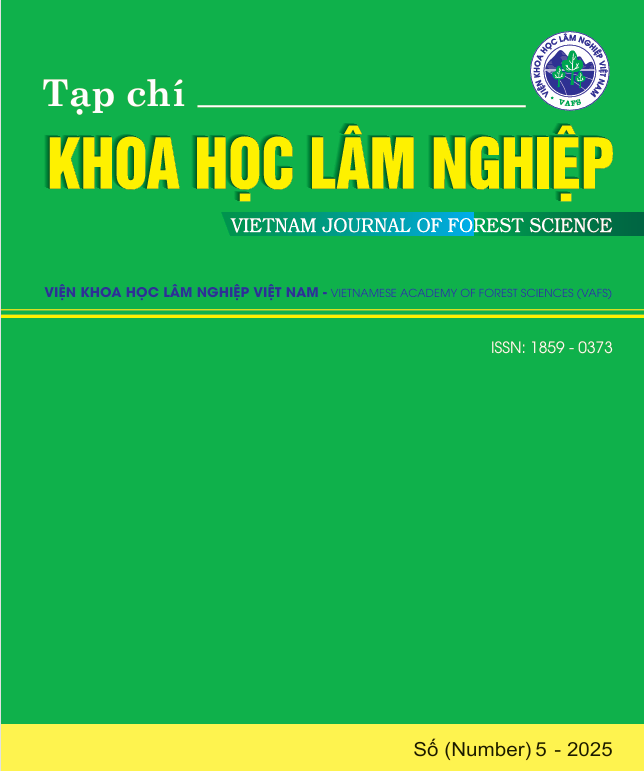RESEARCH ON ASEXUAL PROPAGATION OF Cinnamomum bejolghota (Buch-Ham) Sweet BY CUTTING METHOD
DOI:
https://doi.org/10.70169/VJFS.1052Keywords:
Cuttings, asexual reproduction, Cinnamomum bejolghota (Buch-Ham)Abstract
Cinnamomum bejolghota (Buch-Ham) Sweet is a large multi-purpose tree, sawlog is used to for furniture, houses, and agricultural tools and is very popular among the people. Essential oils are widely used in the cosmetic, food and pharmaceutical industries and have great commercial value in the international market. In order to contribute to the conservation of this tree species forest genetic resources and the development for essential oil extraction, research on asexual propagation techniques by cuttings contributes to accelerating the production of seedlings from cuttings for the species’ cultivation. Research results showed that growth regulators affected the number of roots/cutting and the rooting rate of cuttings. The suitable growth regulator for Cinnamomum bejolghota cuttings was IBA at 1.5% concentration which gave high rooting rate of 72.00%, average number of roots/cutting of 5.15/cutting and average root length of 6,06 cm after 120 days. The rooting rate of the Spring crop was 74.67% and the Autumn crop wa 75.33%. However, the Spring crop had a higher average number of roots/cutting than the Autumn crop, reaching 7.21/cutting and 5.03/cutting respectively after 120 days. The location of the cuttings affected the rooting rate of cuttings, the rooting rate of the tip/tip-branch cutting was 72.67% and the tip-adjacent cutting was 49.33%.
References
1. Võ Văn Chi, 2003. Từ điển thực vật thông dụng Tập 1. Nhà xuất bản Khoa học và Kỹ thuật, trang 670 - 671.
2. Võ Văn Chi, Trần Hợp, 2002. Cây cỏ có ích ở Việt Nam Tập 2. Nhà xuất bản Giáo dục, trang 940.
3. Dao N K, Hop T and Siemonsma J S, 1999. Cinnamomum Schaeffer., In Plant Resources of South-East Asia, de Guzman C C and Siemonsma J S, Eds, Backhuys Publishers, Leiden, 13, 94 - 99.
4. Nguyễn Đức Kiên, 2012. Báo cáo tổng kết đề tài “Nghiên cứu chọn, nhân giống và kỹ thuật gây trồng Giổi xanh (Michelia mediocris Dandy) và Re gừng (Cinnamomum obtusifolium (Roxb.) Nees)”. Viện Khoa học Lâm nghiệp Việt Nam.
5. Nguyễn Hoàng Nghĩa, 2012. Át lát cây rừng Việt Nam tập 4. Nhà xuất bản Nông nghiệp, Hà Nội.
6. Nguyễn Thị Nhung, 2009. Ứng dụng tiến bộ kỹ thuật xây dựng mô hình trồng rừng gỗ lớn bằng các loài cây bản địa vùng Trung tâm Bắc bộ. Báo cáo tổng kết đề tài Viện Khoa học Lâm nghiệp Việt Nam.
7. Trần Văn Tiến, 2006. Nhân giống một số loài cây rừng bằng phương pháp giâm hom và triển vọng trồng rừng của chúng (Web: https://vafs.gov.vn/vn/nhan-giong-mot-so-loai-cay-rung-bang-phuong-phap-giam-hom-va-trien-vong-trong-rung-cua-chung/).
8. Williams, E.R., Matheson, A.C. and Harwood, C.E., 2002. Experimental design and analysis for use in tree improvement. CSIRO publication, 174 pp. ISBN: 0 643 06259 9.









